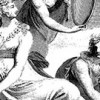
Siobhan Carroll, “On Erasmus Darwin’s The Botanic Garden, 1791-1792″
1792 witnessed the publication of the complete version of Erasmus Darwin’s The Botanic Garden, a lengthy nature poem that surveyed the state of science in its day. The Botanic Garden proved immensely popular on its publication but later fell out of favor as the Anti-Jacobin took aim at its liberal politics. This paper focuses on one of the most notorious sections of the poem, in which Darwin describes his plan to change the world’s climate via iceberg destruction. The argument traces the reception of Darwin’s climate imagery from its initial reception through its redeployment in the poetry of Percy Bysshe Shelley. Although The Botanic Garden and its plan for climate intervention might be framed in terms of what philosophers call the “negative event”—an event that fails to happen—Darwin was essentially correct in his assertion that the technologies of the industrial revolution could be used to change the climate of the globe.

Jane Stabler, “Religious Liberty in the ‘Liberal,’ 1822-23”
A survey of the negative twentieth- and twenty-first-century critical reception of the Liberal; a summary of the history of the journal and a re-evaluation of the philosophical and political coherence of the journal, focusing on its defence of religious liberty and suggesting that religious free thought is a previously overlooked component in the politics of liberalism. The criticism of doctrinal rigidity and advocacy of different forms of religious toleration evident in the four issues of the Liberal support the claim that the journal forms a lucid and intelligible cultural intervention.

Brenda Assael, “On Dinners and Diners and Restaurant Culture in Late Nineteenth-Century London”
Lieutenant Colonel Nathaniel Newnham-Davis’s Dinners and Diners, published in 1899, provides a lively and valuable introduction to the restaurant in late nineteenth-century London, an aspect of Victorian metropolitan experience that has been largely overlooked by historians. This article uses Dinners and Diners to explore three aspects of Victorian metropolitan culture that are dramatized through public eating: first, the centrality of cosmopolitanism; second, the relationship between changing gender roles and new forms of urban sociability; and third, the significance of the theater and theatricality in late-Victorian culture.
